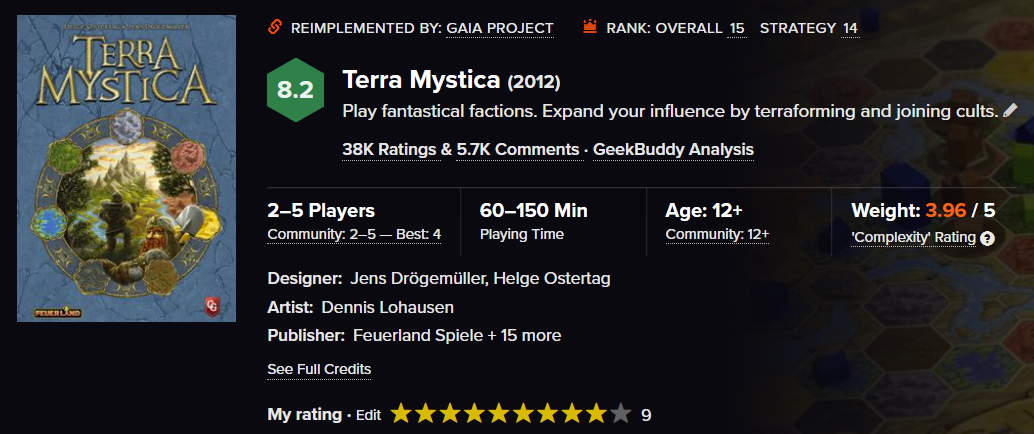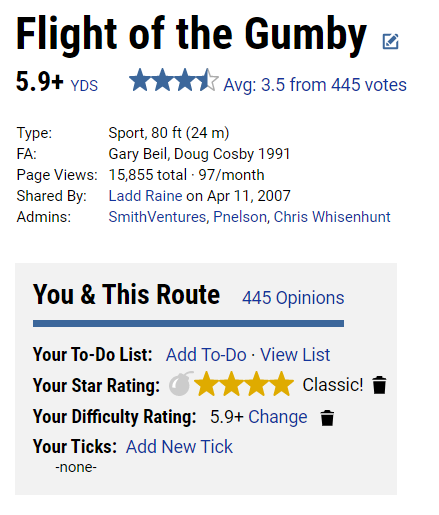Online resources
Board Game Geek and Mountain Project
Mountain Project and Board Game Geek (BGG) are community driven online databases with detailed information, pictures, and ratings of either rock climbs or board games, respectively.
When I started climbing outside, I just followed my mentors and didn’t worry about what we were climbing, how to get there, or how to get down when we were done. The same was true with board games, I just saddled up to the table and played whatever my friends recommended. Yet as I began to grow as a climber, I wanted to become more independent and take agency and responsibility for what I was climbing, learn about more climbing areas, and set informed goals. Now that I’m learning a lot more about games, I also want a deeper understanding about each game, who published it, who are the designers and artists, have they made other games I might like? In come two major online resources to address these questions, Mountain Project and BGG. Here I’ll examine the similarities of how these databases catalog games and rock climbs and how these tools are used!
Difficulty/weight
Rock climbs are rated on a scale from 5.0-5.15 in difficulty, with 5.0-5.7 being beginner, 5.7-5.10 intermediate, 5.10-5.12 advanced, 5.13-5.15 expert or elite. In the example of “Fight of Gumby” above, the 5.9+ tells me this climb is within my wheel house as an intermediate climber and I’m not getting on something well above my limit but it will be a challenge and isn’t too easy either.
On BGG, games are given a weight, or complexity rating on a scale of 1-5, with 1 being a very light introductory game and 5 being a very heavy complex game. This took a while for me to relate to, but once I looked up the weights of a number of games I know well, it began to click. Now, I can look at the weight and if its 4/5 I know its going to take some time to learn and I better be excited about the theme, mechanics, and art if I’m going to invest the energy to learn it.
Star ratings
On Mountain Project, routes have a consensus star rating that rates the relative “quality” of a route. This is highly subjective and can be influenced by many factors such as the exposure, location, views, rock quality, movement, historical context, etc.
BGG is more explicit in their star ratings giving the following suggested breakdown…
10 - Outstanding - will always enjoy playing and expect this will never change.
9 - Excellent - always enjoy playing it
8 - Very good - enjoy playing and would suggest it.
7 - Good - usually willing to play.
6 - Ok - will play if in the mood.
5 - Average - Slightly boring, take it or leave it.
4 - Not so good - but could play again.
3 - Bad - likely won't play this again.
2 - Very bad - won't play ever again.
1 - Awful - defies game description.
Mechanisms and style
Mechanisms of a game are the core elements of a how a game is played. BGG lists this for each game to give a quick overview of how the gameplay proceeds. Some examples I really like are card drafting, worker placement, and simultaneous action selection. Then there are mechanisms that will indicate a game is likely not my style such as dice rolling, direct combat, and player elimination.
Within rock climbing there are several styles, sport, trad, and bouldering (we won’t get into free climbing vs aid here). Sport and trad climbing both use ropes for safety, but climbers ascend the rock using only their bodies. The key difference being that in sport climbing there are bolts permanently affixed to the rock by the route developers and they can be clipped for safety, whereas in trad climbing the climber carries up gear on their harness and places it into the features of the rock to protect them as they climb. This is a key distinction since sport and trad routes can both be present at a particular cliff and it is necessary to know which style you will climb to determine which routes and gear you need to bring.
Other information
BGG provides other valuable information about games including the number of players, the typical time, and age recommendations which are all basic factors that can influence my decisions to play a game or help choose the right time for a particular game. Additionally, the publisher, designer, and artists are all show on the BGG page for a game and this can be useful information to find other games by these creators.
Other critical information Mountain Project provides about climbs includes the length of the route, how to approach/find the route, photographs of the route as useful landmarks, how to descend from the route. Mountain project also lists the people who established and named the route which is usually the person that climbs them first, claiming the First Ascent.
Summary
The resources the climbing and board game communities provide for the enjoyment and education of people within those respective communities are incredible. Mountain Project and BGG are two great examples of how our collective experiences enrich the future for others. However, they should also be taken with a grain of salt, Mountain Project doesn’t have nearly all routes and are just a starting point, local guide books generally prove to be more definitive. However Mountain Project can also be updated quickly and let you know if there is a bees nest or falcon closure in a particular are that isn’t necessarily available in a guide book. The Gunks Apps come the closest to bridging this gap and are my go-to resource for the regions they cover. Lastly, BGG is an exceptional starting point and has many in-depth forums, lists, and features not covered here but it can be a bit daunting and not intuitive to navigate. I will continue to explore and learn more and look forward to reporting back.
Check out the First Ascent BGG page here!
-Garrett Gibbons




